Njengamartin399
On this page, you find all documents, package deals, and flashcards offered by seller njengamartin399.
- 141
- 0
- 7
Community
- Followers
- Following
148 items
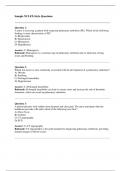
Acute Pulmonary Embolism and Aspiration
Question 1: A nurse is assessing a patient with suspected pulmonary embolism (PE). Which of the following findings is most characteristic of PE? A) Bradycardia B) Hypotension C) Hemoptysis D) Hypothermia Answer: C) Hemoptysis Rationale: Hemoptysis is a common sign of pulmonary embolism due to infarction of lung tissue and bleeding. ________________________________________ Question 2: Which risk factor is most commonly associated with the development of a pulmonary embolism? A) Obesity...
- Exam (elaborations)
- • 19 pages •
Question 1: A nurse is assessing a patient with suspected pulmonary embolism (PE). Which of the following findings is most characteristic of PE? A) Bradycardia B) Hypotension C) Hemoptysis D) Hypothermia Answer: C) Hemoptysis Rationale: Hemoptysis is a common sign of pulmonary embolism due to infarction of lung tissue and bleeding. ________________________________________ Question 2: Which risk factor is most commonly associated with the development of a pulmonary embolism? A) Obesity...
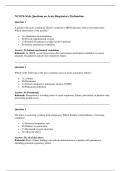
Acute Respiratory Dysfunction
Question 1 A patient with acute respiratory distress syndrome (ARDS) presents with severe hypoxemia. Which intervention is the priority? • A) Administer bronchodilators • B) Provide supplemental oxygen • C) Position the patient in a high Fowler’s position • D) Initiate mechanical ventilation Answer: D) Initiate mechanical ventilation Rationale: In ARDS, severe hypoxemia often necessitates mechanical ventilation to ensure adequate oxygenation and prevent respiratory failure. ___...
- Exam (elaborations)
- • 21 pages •
Question 1 A patient with acute respiratory distress syndrome (ARDS) presents with severe hypoxemia. Which intervention is the priority? • A) Administer bronchodilators • B) Provide supplemental oxygen • C) Position the patient in a high Fowler’s position • D) Initiate mechanical ventilation Answer: D) Initiate mechanical ventilation Rationale: In ARDS, severe hypoxemia often necessitates mechanical ventilation to ensure adequate oxygenation and prevent respiratory failure. ___...
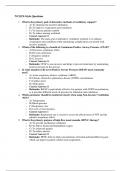
Alternative Methods of Ventilatory Support
1. What is the primary goal of alternative methods of ventilatory support? o A) To eliminate the need for intubation o B) To improve oxygenation and ventilation o C) To increase patient comfort o D) To reduce nursing workload o Correct Answer: B o Rationale: The main goal of alternative ventilatory methods is to enhance oxygenation and ventilation while minimizing complications associated with invasive methods. 2. Which of the following is a benefit of Continuous Positive Airway Pressure ...
- Exam (elaborations)
- • 12 pages •
1. What is the primary goal of alternative methods of ventilatory support? o A) To eliminate the need for intubation o B) To improve oxygenation and ventilation o C) To increase patient comfort o D) To reduce nursing workload o Correct Answer: B o Rationale: The main goal of alternative ventilatory methods is to enhance oxygenation and ventilation while minimizing complications associated with invasive methods. 2. Which of the following is a benefit of Continuous Positive Airway Pressure ...
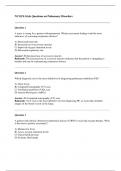
Diagnosis and Treatment of Pulmonary Disorders
Question 1 A nurse is caring for a patient with pneumonia. Which assessment finding would be most indicative of worsening respiratory distress? A) Decreased heart rate B) Increased use of accessory muscles C) Improved oxygen saturation levels D) Decreased respiratory rate Answer: B) Increased use of accessory muscles Rationale: The increased use of accessory muscles indicates that the patient is struggling to breathe and may be experiencing respiratory distress. _________________________...
- Exam (elaborations)
- • 21 pages •
Question 1 A nurse is caring for a patient with pneumonia. Which assessment finding would be most indicative of worsening respiratory distress? A) Decreased heart rate B) Increased use of accessory muscles C) Improved oxygen saturation levels D) Decreased respiratory rate Answer: B) Increased use of accessory muscles Rationale: The increased use of accessory muscles indicates that the patient is struggling to breathe and may be experiencing respiratory distress. _________________________...
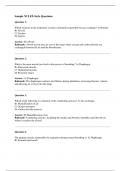
Pulmonary Anatomy and Physiology
Question 1: Which structure in the respiratory system is primarily responsible for gas exchange? A) Bronchi B) Alveoli C) Trachea D) Larynx Answer: B) Alveoli Rationale: Alveoli are the tiny air sacs in the lungs where oxygen and carbon dioxide are exchanged between the air and the bloodstream. ________________________________________ Question 2: What is the main muscle involved in the process of breathing? A) Diaphragm B) Intercostal muscles C) Abdominal muscles D) Pectoralis major ...
- Exam (elaborations)
- • 18 pages •
Question 1: Which structure in the respiratory system is primarily responsible for gas exchange? A) Bronchi B) Alveoli C) Trachea D) Larynx Answer: B) Alveoli Rationale: Alveoli are the tiny air sacs in the lungs where oxygen and carbon dioxide are exchanged between the air and the bloodstream. ________________________________________ Question 2: What is the main muscle involved in the process of breathing? A) Diaphragm B) Intercostal muscles C) Abdominal muscles D) Pectoralis major ...
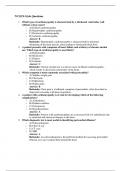
Cardiomyopathies and Pericarditis
1. Which type of cardiomyopathy is characterized by a thickened ventricular wall without a clear cause? o A) Dilated cardiomyopathy o B) Hypertrophic cardiomyopathy o C) Restrictive cardiomyopathy o D) Ischemic cardiomyopathy Answer: B Rationale: Hypertrophic cardiomyopathy is characterized by abnormal thickening of the heart muscle, often leading to obstructed blood flow. 2. A patient presents with symptoms of heart failure and a history of chronic alcohol use. Which type of cardiomyopat...
- Exam (elaborations)
- • 12 pages •
1. Which type of cardiomyopathy is characterized by a thickened ventricular wall without a clear cause? o A) Dilated cardiomyopathy o B) Hypertrophic cardiomyopathy o C) Restrictive cardiomyopathy o D) Ischemic cardiomyopathy Answer: B Rationale: Hypertrophic cardiomyopathy is characterized by abnormal thickening of the heart muscle, often leading to obstructed blood flow. 2. A patient presents with symptoms of heart failure and a history of chronic alcohol use. Which type of cardiomyopat...
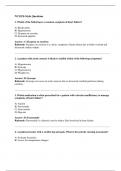
Treatment of Cardiac, Valvular, and Vascular Insufficiency, and Trauma
1. Which of the following is a common symptom of heart failure? A) Bradycardia B) Hypertension C) Dyspnea on exertion D) Increased appetite Answer: C) Dyspnea on exertion Rationale: Dyspnea on exertion is a classic symptom of heart failure due to fluid overload and decreased cardiac output. ________________________________________ 2. A patient with aortic stenosis is likely to exhibit which of the following symptoms? A) Hypertension B) Syncope C) Hyperactivity D) Weight loss Answer:...
- Exam (elaborations)
- • 17 pages •
1. Which of the following is a common symptom of heart failure? A) Bradycardia B) Hypertension C) Dyspnea on exertion D) Increased appetite Answer: C) Dyspnea on exertion Rationale: Dyspnea on exertion is a classic symptom of heart failure due to fluid overload and decreased cardiac output. ________________________________________ 2. A patient with aortic stenosis is likely to exhibit which of the following symptoms? A) Hypertension B) Syncope C) Hyperactivity D) Weight loss Answer:...
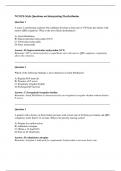
.Interpreting Dysrhythmias.Interpreting Dysrhythmias
A nurse is monitoring a patient who suddenly develops a heart rate of 150 beats per minute with narrow QRS complexes. What is the most likely dysrhythmia? A) Atrial fibrillation B) Supraventricular tachycardia (SVT) C) Ventricular tachycardia D) Sinus tachycardia Answer: B) Supraventricular tachycardia (SVT) Rationale: SVT is characterized by a rapid heart rate with narrow QRS complexes originating above the ventricles. ________________________________________ Question 2 Which of the fo...
- Exam (elaborations)
- • 21 pages •
A nurse is monitoring a patient who suddenly develops a heart rate of 150 beats per minute with narrow QRS complexes. What is the most likely dysrhythmia? A) Atrial fibrillation B) Supraventricular tachycardia (SVT) C) Ventricular tachycardia D) Sinus tachycardia Answer: B) Supraventricular tachycardia (SVT) Rationale: SVT is characterized by a rapid heart rate with narrow QRS complexes originating above the ventricles. ________________________________________ Question 2 Which of the fo...
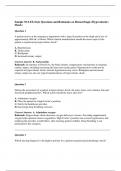
Hemorrhagic (Hypovolemic) Shock
Question 1 A patient arrives at the emergency department with a large laceration on the thigh and a loss of approximately 800 mL of blood. Which clinical manifestation should the nurse expect if the patient is experiencing hypovolemic shock? A. Hypertension B. Tachycardia C. Bradypnea D. Increased urinary output Correct Answer: B. Tachycardia Rationale: In response to blood loss, the body initiates compensatory mechanisms to maintain cardiac output, including increasing the heart rate (ta...
- Exam (elaborations)
- • 23 pages •
Question 1 A patient arrives at the emergency department with a large laceration on the thigh and a loss of approximately 800 mL of blood. Which clinical manifestation should the nurse expect if the patient is experiencing hypovolemic shock? A. Hypertension B. Tachycardia C. Bradypnea D. Increased urinary output Correct Answer: B. Tachycardia Rationale: In response to blood loss, the body initiates compensatory mechanisms to maintain cardiac output, including increasing the heart rate (ta...
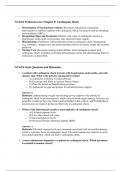
Cardiogenic Shock
1. Prioritization of Nursing Interventions: Recognize and prioritize immediate interventions to stabilize a patient with cardiogenic shock, focusing on airway, breathing, and circulation (ABCs). 2. Recognizing Signs and Symptoms: Identify early signs of cardiogenic shock (e.g., hypotension, tachycardia, cool clammy skin, decreased urine output). 3. Pharmacology: Familiarize with medications used in cardiogenic shock management (e.g., inotropes, vasopressors) and understand their effects on car...
- Exam (elaborations)
- • 16 pages •
1. Prioritization of Nursing Interventions: Recognize and prioritize immediate interventions to stabilize a patient with cardiogenic shock, focusing on airway, breathing, and circulation (ABCs). 2. Recognizing Signs and Symptoms: Identify early signs of cardiogenic shock (e.g., hypotension, tachycardia, cool clammy skin, decreased urine output). 3. Pharmacology: Familiarize with medications used in cardiogenic shock management (e.g., inotropes, vasopressors) and understand their effects on car...
